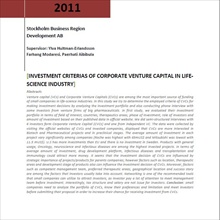Members Login

Channels
Special Offers & Promotions
Investment strategies of corporate venture capital in life science industry revealed in new report
publication date: Dec 14, 2011
|
author/source: Stockholm Business Region
 The US continues to dominate; most venture
capital goes to drug discovery platforms and the most successful companies in
need of capital are those who most clearly fit in to investors' overarching
strategy. In addition, despite often leading R&D positions, Swedish life
science companies must improve international relations in order to succeed in
attracting investments. This emerged in a new report on the venture capital
investments of global life science companies.
The US continues to dominate; most venture
capital goes to drug discovery platforms and the most successful companies in
need of capital are those who most clearly fit in to investors' overarching
strategy. In addition, despite often leading R&D positions, Swedish life
science companies must improve international relations in order to succeed in
attracting investments. This emerged in a new report on the venture capital
investments of global life science companies. One of the most important sources of capital supply for small and medium-sized life science enterprises is the large pharmaceutical companies' own venture capital operations, so-called corporate venture capital companies. Farhang Modaresi and Parhat Hebibul, master students in Karolinska Institutet's bioentrepreneurship program, were commissioned by Stockholm Business Region to map the last ten years' investments globally and interview key individuals to investigate the decision-making process.
The conclusion of their research is clear. "Small companies in need of venture capital must analyze large pharmaceutical companies' portfolios, become familiar with their focus and preferences and meet investors before they submit a proposal. Networking is probably more important than many people think," says Farhang Modaresi from Karolinska Institutet.
The data are based on the 300 most recent investments of the 19 biggest private equity investment companies over the past decade. Additional in-depth interviews were conducted with seven investors. The purpose of the report is to identify general success factors, thus supporting the Stockholm region's life science companies in pursuit of venture capital. None of the investments were made in Sweden during that period, despite the fact that the sector accounts for approximately 20 percent of Sweden's net exports.
"Given the major research campaigns, it is surprising that none of the pharmaceutical companies' venture capital investments were in Sweden and Stockholm. In many cases, our companies pursue world-leading, cutting-edge research and investors are extremely curious. However, the report clearly shows that experienced leadership with a broad international network is essential," says Ylva Hultman Erlandsson, Business Development Manager Life Science at Stockholm Business Region Development.
The report in brief
Biggest investment area: Biotechnology
Highest average amount investment: USD 65 million, Roche
Lowest average amount investment: USD 11.5 million, Mitsubishi
Most active investors: Roche, Takeda and Novartis
Phase with the most investments: Preclinical phase
Phase with the biggest investments: Phase 3
Therapeutic areas with the most investments: Oncology, neurology and infectious diseases
Areas with biggest investments: Drug discovery platforms, infectious diseases, transplantation and immunology
Important investment factors: Strategic link to the parent company, geography, therapeutic area and development phase
Success factors for companies in need of capital: Experienced and competent leadership, place of legal residence and references such as past successes
Taxes and wage level: Has no crucial significance for an investment decision
Download the report here: http://tinyurl.com/cvcinvestments.
About Stockholm Business Region
Stockholm Business Region is the official investment and visitor promotion agency for the Stockholm region. Stockholm is one of Europe's most dynamic regions. With continual high growth, world-leading clusters within Life Science and ICT, and as a center for fashion and design, Stockholm is the natural capital city of Scandinavia. www.investstockholm.com
Media Partners


